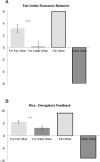The Impact of Emotions and Empathy-Related Traits on Punishment Behavior: Introduction and Validation of the Inequality Game
- PMID: 26978065
- PMCID: PMC4792486
- DOI: 10.1371/journal.pone.0151028
The Impact of Emotions and Empathy-Related Traits on Punishment Behavior: Introduction and Validation of the Inequality Game
Abstract
In the prevention and resolution of conflicts in social contexts, an important step is to understand how different emotions and empathic traits are linked to punishment behaviors. Unfortunately, few paradigms exist to study these phenomena. Here, we developed the Inequality Game (IG) as an economic and verbal interaction paradigm in which participants are faced with an "unfair other" as opposed to a "fair other" and subsequently have the opportunity to engage in a range of social behaviors. These social behaviors include cooperative or competitive economic choices and nice or derogatory verbal behavior toward the unfair and fair other. Participants could thus engage in punishment or forgiveness behavior toward the unfair other as well as in cooperative or aggressive behavior toward the fair other. We validated the IG through multimodal measures comprising the assessment of personality traits, emotions (by means of facial expressions and self-reports), arousal (by means of skin conductance responses), physical effort (force exertion), and behavioral reactions. Second, we examined the influence of emotions and empathy-related traits on punishment behavior. With regard to emotions, we observed a positive relation between malicious joy and punishment behavior. This result highlights the role of reward-related mechanisms in favoring punishment behavior. In addition, different empathic traits had opposing effects on antisocial behavior. Whereas personal distress predicted aggressive verbal behavior, perspective taking and empathic concern predicted a reduction in punishment behavior. Empathic traits also modulated emotional experience and person evaluations, such that perspective taking was related to more positive affect (less frowning and more smiling) and a more favorable evaluation of the unfair other. The current data validate the IG, reveal that malicious joy is positively related to punishment behavior, and show that different types of empathic traits can have opposing effects on antisocial behavior as well as on related emotions and person evaluations.
Conflict of interest statement
Figures





Similar articles
-
Empathic neural responses are modulated by the perceived fairness of others.Nature. 2006 Jan 26;439(7075):466-9. doi: 10.1038/nature04271. Epub 2006 Jan 18. Nature. 2006. PMID: 16421576 Free PMC article.
-
Helping behavior induced by empathic concern attenuates anterior cingulate activation in response to others' distress.Soc Neurosci. 2016;11(2):109-22. doi: 10.1080/17470919.2015.1049709. Epub 2015 Jun 2. Soc Neurosci. 2016. PMID: 26032190
-
Empathic Skills and Cyberbullying: Relationship of Different Measures of Empathy to Cyberbullying in Comparison to Offline Bullying Among Young Adults.J Genet Psychol. 2017 Jan-Feb;178(1):58-72. doi: 10.1080/00221325.2016.1256155. J Genet Psychol. 2017. PMID: 28121287
-
The neuronal basis of empathy and fairness.Novartis Found Symp. 2007;278:20-30; discussion 30-40, 89-96, 216-21. Novartis Found Symp. 2007. PMID: 17214308 Review.
-
The plasticity of social emotions.Soc Neurosci. 2015;10(5):466-73. doi: 10.1080/17470919.2015.1087427. Epub 2015 Sep 15. Soc Neurosci. 2015. PMID: 26369728 Review.
Cited by
-
Getting closer: compassion training increases feelings of closeness toward a disliked person.Sci Rep. 2023 Oct 26;13(1):18339. doi: 10.1038/s41598-023-45363-1. Sci Rep. 2023. PMID: 37884610 Free PMC article. Clinical Trial.
-
Distinct Brain Areas involved in Anger versus Punishment during Social Interactions.Sci Rep. 2018 Jul 12;8(1):10556. doi: 10.1038/s41598-018-28863-3. Sci Rep. 2018. PMID: 30002411 Free PMC article.
-
Hit or Run: Exploring Aggressive and Avoidant Reactions to Interpersonal Provocation Using a Novel Fight-or-Escape Paradigm (FOE).Front Behav Neurosci. 2017 Oct 17;11:190. doi: 10.3389/fnbeh.2017.00190. eCollection 2017. Front Behav Neurosci. 2017. PMID: 29089875 Free PMC article.
-
Burnout as a Mediator in the Relationship between Work-Life Balance and Empathy in Healthcare Professionals.Psychiatry Investig. 2020 Sep;17(9):951-959. doi: 10.30773/pi.2020.0147. Epub 2020 Sep 17. Psychiatry Investig. 2020. PMID: 32933235 Free PMC article.
-
Structural Differences in Insular Cortex Reflect Vicarious Injustice Sensitivity.PLoS One. 2016 Dec 8;11(12):e0167538. doi: 10.1371/journal.pone.0167538. eCollection 2016. PLoS One. 2016. PMID: 27930678 Free PMC article.
References
-
- Carnevale PJD, Isen AM. The influence of positive affect and visual access on the discovery of integrative solutions in bilateral negotiation. Organ Behav Hum Decis Process. 1986;37(1): 1–13.
-
- Berkowitz L. On the formation and regulation of anger and aggression: A cognitive-neoassociationistic analysis. Am Psychol. 1990;45(4): 494 - PubMed
-
- Batson CD, O'Quin K, Fultz J, Vanderplas M, Isen AM. Influence of self-reported distress and empathy on egoistic versus altruistic motivation to help. J Pers Soc Psychol. 1983;45(3): 706–718.
-
- Taylor SP. Aggressive behavior and physiological arousal as a function of provocation and tendency to inhibit aggression. J Pers. 1967;35(2): 297–310. - PubMed
Publication types
MeSH terms
LinkOut - more resources
Full Text Sources
Other Literature Sources

